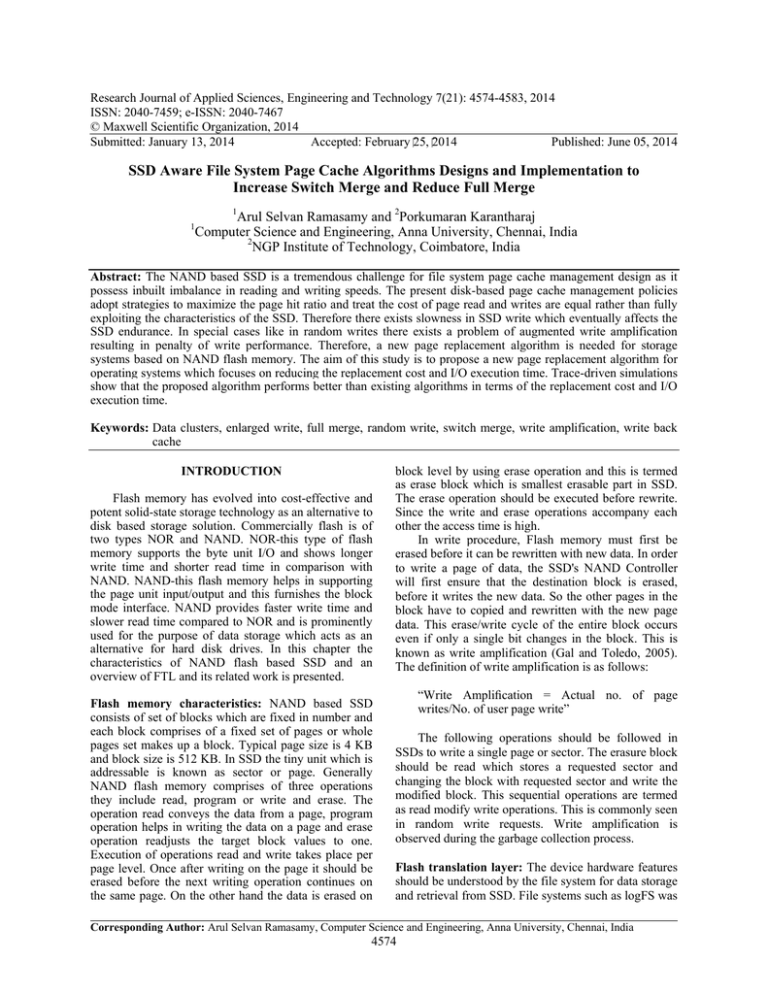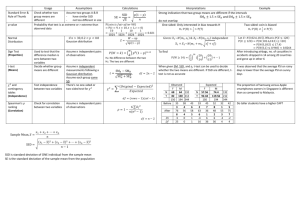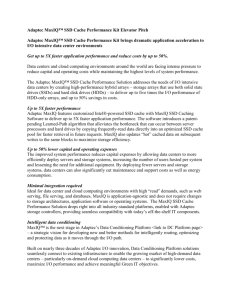Research Journal of Applied Sciences, Engineering and Technology 7(21): 4574-4583,... ISSN: 2040-7459; e-ISSN: 2040-7467
advertisement

Research Journal of Applied Sciences, Engineering and Technology 7(21): 4574-4583, 2014
ISSN: 2040-7459; e-ISSN: 2040-7467
© Maxwell Scientific Organization, 2014
Submitted: January 13, 2014
Accepted: February 25, 2014
Published: June 05, 2014
SSD Aware File System Page Cache Algorithms Designs and Implementation to
Increase Switch Merge and Reduce Full Merge
1
Arul Selvan Ramasamy and 2Porkumaran Karantharaj
Computer Science and Engineering, Anna University, Chennai, India
2
NGP Institute of Technology, Coimbatore, India
1
Abstract: The NAND based SSD is a tremendous challenge for file system page cache management design as it
possess inbuilt imbalance in reading and writing speeds. The present disk-based page cache management policies
adopt strategies to maximize the page hit ratio and treat the cost of page read and writes are equal rather than fully
exploiting the characteristics of the SSD. Therefore there exists slowness in SSD write which eventually affects the
SSD endurance. In special cases like in random writes there exists a problem of augmented write amplification
resulting in penalty of write performance. Therefore, a new page replacement algorithm is needed for storage
systems based on NAND flash memory. The aim of this study is to propose a new page replacement algorithm for
operating systems which focuses on reducing the replacement cost and I/O execution time. Trace-driven simulations
show that the proposed algorithm performs better than existing algorithms in terms of the replacement cost and I/O
execution time.
Keywords: Data clusters, enlarged write, full merge, random write, switch merge, write amplification, write back
cache
INTRODUCTION
Flash memory has evolved into cost-effective and
potent solid-state storage technology as an alternative to
disk based storage solution. Commercially flash is of
two types NOR and NAND. NOR-this type of flash
memory supports the byte unit I/O and shows longer
write time and shorter read time in comparison with
NAND. NAND-this flash memory helps in supporting
the page unit input/output and this furnishes the block
mode interface. NAND provides faster write time and
slower read time compared to NOR and is prominently
used for the purpose of data storage which acts as an
alternative for hard disk drives. In this chapter the
characteristics of NAND flash based SSD and an
overview of FTL and its related work is presented.
Flash memory characteristics: NAND based SSD
consists of set of blocks which are fixed in number and
each block comprises of a fixed set of pages or whole
pages set makes up a block. Typical page size is 4 KB
and block size is 512 KB. In SSD the tiny unit which is
addressable is known as sector or page. Generally
NAND flash memory comprises of three operations
they include read, program or write and erase. The
operation read conveys the data from a page, program
operation helps in writing the data on a page and erase
operation readjusts the target block values to one.
Execution of operations read and write takes place per
page level. Once after writing on the page it should be
erased before the next writing operation continues on
the same page. On the other hand the data is erased on
block level by using erase operation and this is termed
as erase block which is smallest erasable part in SSD.
The erase operation should be executed before rewrite.
Since the write and erase operations accompany each
other the access time is high.
In write procedure, Flash memory must first be
erased before it can be rewritten with new data. In order
to write a page of data, the SSD's NAND Controller
will first ensure that the destination block is erased,
before it writes the new data. So the other pages in the
block have to copied and rewritten with the new page
data. This erase/write cycle of the entire block occurs
even if only a single bit changes in the block. This is
known as write amplification (Gal and Toledo, 2005).
The definition of write amplification is as follows:
“Write Amplification = Actual no. of page
writes/No. of user page write”
The following operations should be followed in
SSDs to write a single page or sector. The erasure block
should be read which stores a requested sector and
changing the block with requested sector and write the
modified block. This sequential operations are termed
as read modify write operations. This is commonly seen
in random write requests. Write amplification is
observed during the garbage collection process.
Flash translation layer: The device hardware features
should be understood by the file system for data storage
and retrieval from SSD. File systems such as logFS was
Corresponding Author: Arul Selvan Ramasamy, Computer Science and Engineering, Anna University, Chennai, India
4574
Res. J. Appl. Sci. Eng. Technol., 7(21): 4574-4583, 2014
practiced on SSD by understanding the characteristics.
However the dependency of a particular file system
becomes mandatory and in this approach the
performance and endurance of SSD is not addressed
completely.
But the updated high performance SSD’s,
comprises of a program known as Flash Translations
Layer (FTL) which helps in managing the flash
memory. The FTL possess following characteristics, It
abstracts the hardware features of device therefore it is
called as pseudo file system. It presents block device
(Intel Corporation, 1998) interface by hiding the
hardware characteristics of NAND device and the file
system consumes the interface. FTL maps the logical
address space into physical locations of the flash
memory is done by FTL. It also helps in operations like
garbage collection and wear leveling. For device
endurance and high performance read and write cycles
diverse algorithms are required and FTL contains these
algorithms. The basic function of FTL algorithm is to
map the page number from logical to physical and these
mapping entry data is preserved in random access
memory. The FTL address mapping procedures are
classified into three categories namely, block level
mapping, page level mapping and hybrid mapping.
Hybrid mapping is used in the recent FTL’s which
uses both page and block mapping techniques to create
a hybrid FTL. By doing this the random access memory
usage of page mapping can be minimized and there will
reduction in erase counts related to block mapping. The
example for this is log block based FTL. This executes
through a principle of writing a page into a log block by
using page mapping and allows the mapping of the
page anywhere inside the block. The action of garbage
collection enters the role when the log block is
completely filled. The victim block is selected by the
FTL and it merges with corresponding data blocks.
Depending upon the situation the merge operation is
generally of three types such as switch, partial and full
merge.
When complete pages in the data block are
invalidated, the log block moves to the new data block
and erases the old one then switch merge arises
(Fig. 1). Partial merge arises (Fig. 2) if every valid page
is to be copied to the remaining empty block places in
the log block. Full merge (Fig. 3) needs 2 block
erasures like ‘n’ page writes and ‘n’ page reads. The
synonym for full merge is normal merge. This merge
assigns a free block which is erased before and copies
the recent updated valid pages into this free space.
These valid pages are collected either from log block or
data block. Once after completion of copying the free
block is replaced by data block and the log blocks and
previous data blocks are erased.
Though hybrid FTL is advanced compared with
block based or pure page FT, still the performance is
poor due to read, write and erases merge operations for
random writes (Min et al., 2012). For better scale up of
flash potential this poor performance should be
addressed. Advanced research has mainly focused on
the improvement of random write performances of flash
by the addition of DRAM-backed buffers and also on
implementation of buffering write requests by
employing page cache algorithms.
Garbage collection and wear leveling: In the flash
data delete operation, data is obsoleted not deleted.
Obsolete data still occupies storage and cannot be
deleted alone in the same erase block. Therefore a
garbage collector is required to clean an erase block by
moving all valid data into a free erase block, obsoleting
old erase block. For the preparation of new incoming
data, the data which is valid is separated from the
invalid data and is moved to an unoccupied storage
area. As a result the invalid data containing block is
erased. This process of collecting, moving of valid data
and erasing the invalid data is called as garbage
collection. Through SSD firmware command TRIM
(Shu and Obr, 2007) the garbage collection is triggered
for deleted file blocks by the file system. To
communicate that a range of logical pages usage is no
longer an ATA inter face standard called TRIM is used.
This garbage collection used for flash file systems is
similar to that of segment cleaning method in log
structured file systems (Rosenblum and Ousterhou,
1992). Although garbage collection enhances the
performance but it involves an additional cost of
computation and live data migrations.
Commonly used erase blocks puts off quickly,
slows down access times and finally burning out.
Therefore the erase count of each erase block should be
monitored. There are wide number of wear-leveling
techniques used in FTL to address this problem.
Motivation and contribution: SSD write performance
and device endurance is affected by the write
amplification. Most of the file systems perform suboptimally when running on top of SSDs with FTL
technology. This suboptimal performance is attributed
by the poor random write (Qiu and Reddy, 2013)
performance in SSDs. Particularly SSD performance
gets affected on random write workloads on overwrite
file systems. Random writes also shortens the lifespan
of SSDs as these writes include more block erases for
every write. So designing the operating system’s page
replacement algorithm is very crucial for SSD writes.
Especially for over write file systems, the host based
page replacement algorithm for SSD must be designed
factoring the write amplification scenario. However,
this new cache replacement method should not affect
the host cache expulsion rate which leads to over or
under use of file system page cache. Hence, the flashaware host based page cache replacement algorithm
should drive the FTL for the probability of reduced
partial, full merges and increased switch merges.
4575
Res. J. Appl. Sci. Eng. Technol., 7(21): 4574-4583, 2014
Fig. 1: FTL switch merge-one erase operation
Fig. 3: FTL full merge-two erase operations+live data copy
We summarize the basic principles of the proposed
flash-aware host based page cache replacement
algorithm as follows. The algorithm drives the FTL for
the increased probability converting full and partial
merge to switch merge; this is the design construct for
our algorithm. The following are the design principles
of the algorithm:
•
•
•
Fig. 2: FTL partial merge-one erase operation+live data copy
Cluster the dirty pages for write efficiency
Convert the random work load into sequential
workload through write enlargement
Clean page eviction policies to enhance the spatial
locality and to support the write enlargement
This algorithm maximizes the present LRU (Least
Recently Used) algorithm’s efficiency. Depending upon
the design principles various cache management
strategies are developed and implemented on the LRU
algorithm. K-means (Lloyd, 1982) clustering algorithm
is used for dirty page clustering to form write clusters.
Generally, in regular application SSD’s need sequential
work load for high write throughput and it is difficult to
assure in real time. Hence a set of cache management
policies are developed to make sure that the writes are
sequential in nature. The probability of page writes
targeting on a specific SSD erasure block is increased
by applying these policies. The proposal is termed as
CSWLRU, which means Clustering dirty pages and
4576
Res. J. Appl. Sci. Eng. Technol., 7(21): 4574-4583, 2014
Sequential Write formation on Least Recently Used.
The results were promising on implementation of this
CSWLRU in a trace driven simulation environment
compared to the previously proposed algorithms.
LITERATURE REVIEW
CFLRU Park et al. (2006) and LRUWSR (Jung
et al., 2008) are based on modified form of LRU
algorithm and is a flash aware page replacement
strategy for operating systems. In CFLRU algorithm,
the LRU list is divided into two parts. In clean-first
region, the clean pages are selected as victims over
dirty pages. Only in the absence of clean pages in clean
first region the dirty pages are selected as victim pages.
The buffer place for dirty pages is effectively increased
by evicting the clean pages. Hence the flash write
number reduces. LRUWSR uses only a single list as
auxiliary data structure. The scheme of this LRUWSR
is to maintain hot-dirty pages as buffer and eject the
cold-dirty pages. If there is a necessary for victim page,
the search begins from LRU end of the list. If a clean
page is visited, it will be returned immediately (LRU
and clean-first strategy). If a dirty page is visited and is
marked “cold”, it will be returned; otherwise, it will be
marked “cold” and the search continues. This strategy
increases the page read count but reduces the number of
page writes. As a result this algorithm improves the
overall performance of SSD. CFLRU and LRU-WSR
do not address the write patterns.
The order of write is important to reduce the
average cost of each write. WOW (Gill and Modha,
2005) groups the pages in write groups and sorts them
in logical order based on the physical proximity on the
disk. WOW solves the write order and STOW (Gill
et al., 2009) solves the write pace problem. STOW
algorithm exploits the spatial and temporal locality by
partitioning the dirty pages into sequential and random
queue. By doing so it provides better control on page
eviction and minimizes the one time sequential write
cache pollution. Both WOW and STOW is proposed for
the write performance in disk based storage system.
In Btrfs (http://btrfs.wiki.kernel.org.) and WAFL
(Hitz et al., 1994) file systems, always the dirty pages
are written into new pages. Btrfs uses TRIM command
for reporting the free blocks to the firmware and it is a
SSD aware file system. Btrfs has effective
optimizations like omitting the unnecessary seeks and
writing group of dirty pages, even if they are from
unrelated files. The outcome is faster write throughput
and larger write operations.
JFFS2 Woodhouse (2001) is a log-structured file
system designed and optimized for raw flash devices
and not FTL aware. JFFS2 is aware of the restrictions
imposed by flash technology and which operates
directly on the flash chips, thereby avoiding the
inefficiency of having two journaling file systems on
top of each other. IotaFS (Cook et al., year) is SSD
optimized file system which places the random write
into convenient write locations to lessen the impact of
erase block copying overhead. In addition to this
allocation is done on erasure block units to achieve
spatial locality of writes for high throughput. FAB (Jo
et al., 2006) is one more buffer cache management
policy used for flash memory. In this the buffers of the
same erase blocks are grouped together on LRU
sequence and victim groups are larger which are based
on the page count on every group. In sequential writes
FAB plays an effective role.
CDFC (Ou et al., 2010) and CASA (Ou and
Harder, 2010) are improvements of the CFLRU
algorithm. Clean-First Dirty-Clustered (CFDC) is a
flash aware buffer management algorithm which gives
first priority for clean buffer pages in replacement
process. The dirty pages are grouped for better spatial
locality of the page flushes. This algorithm was
incorporated with conventional page replacement
algorithm and evaluation of performance is done in data
bases. CASA improves CFLRU by automatically
adjusting the size of buffer portions allocated for clean
and dirty pages according to the storage device’s
read/write cost ratio.
DESIGN OF CUSTERING AND COMPOSING
SEQUENTIAL WRITE ON LEAST
RECENTLY USED
CSWLRU is a host based page cache management
scheme, host consists of CPU, a file system and the
system page cache. Figure 4 shows the general system
configuration considered in this study.
CSWLRU is combination of three techniques
namely, dirty page clustering, enlarged write through
read ahead write cache and frequency and distance
based clean page eviction.
CSWLRU K-means page clustering: Clustering is an
important tool for automated analysis of data.
CSWLRU utilizes K-means clustering technique on
dirty pages. Clustering dirty pages with large
granularity will help to convert the random work load
into sequential workload. For a given set of ‘n’ data
points, the algorithm partitions the points into ‘k’
clusters. In k means clustering algorithm, initially the
number of clusters known as ‘k’ value should be
specified. After the ‘k’ value is determined, these ‘k’
points are selected as cluster centers. According to
Euclidean (Aloise et al., 2009) distance metric all
instances which are needed to be divided are assigned
to their nearest cluster centers.
Lloyd’s algorithm (Lloyd, 1982) is the most
accepted method used for calculating k-means. One
dimensional dirty page of length ‘n’ acts as input for
this algorithm. The initial ‘k’ value or partition
boundary is calculated based on the erasure block size.
4577
Res. J. Appl. Sci. Eng. Technol., 7(21): 4574-4583, 2014
Fig. 5: An example of read ahead cache. The clean pages C3
and C6 are read from SSD to form a sequential write.
C-clean page D-dirty page
Fig. 4: System configuration CSWLRU is applied to the host
file system
This indicates the number of cluster means production
which translates to the number of clustered writes on
SSD. In each and every iteration, the continuous kmean algorithm examines only a random sample of data
points where as CSWLRU examines all data points in
sequence. The algorithm is in following flow:
•
•
•
•
•
•
•
One dimensional pages of length ‘n’ is the input
and ‘k’ indicates the number of cluster means
produced.
Choose ‘k’ values from the ‘n’ dirty pages with the
block boundary heuristic mentioned above.
Ordering and selecting the initial k values shorten
the conversion time.
As these values are potential means they are named
as k-means.
Further, using square distance method each block
is grouped with the nearest mean value.
By the end of this step, all the data points belong to
potential mean group.
At this iteration, the new mean is derived by
calculating the average of all data points.
The process is repeated until no change is observed
in the centroid.
After a few number of iterations, the squared error
stops to decrease prominently or is unchanged. Below
is the example:
Input values {1, 3, 5, 12, 52, 25, 13, 571, 834, 432,
489, 8, 45, 60, 2, 11}
k = 2→ {432, 489, 571, 834}, {1, 2, 3, 5, 8, 11, 12,
13, 25, 45, 52, 60}
k = 3→ {834}, {432, 489, 571}, {1, 2, 3, 5, 8, 11,
12, 13, 25, 45, 52, 60}
Clustering the dirty pages increases the probability
of switch merges. CSWLRU uses the k-means
algorithm by examining all dirty pages and produces
the dirty page clusters.
CSWLRU-read ahead write cache: K-means
clustering produces clusters of dirty pages and most of
the time the clustered pages are not continuous. For
accelerating the switch merges count, the pages should
be adjoining and arrayed with SSD erasure block
borders. For the formation of continuous writes, the
clean pages are brought into cache after reading from
SSD. Or else, relatively expensive full merge or partial
occurs instead of a switch merge. As the pages are read
and cached for write it is named as read ahead write
cache or enlarged writes. Page cache algorithm is also
implemented by FTL for detecting the scope of erasure
block cache based on few set of rules for example last
page write in the erasure block or sequential write
operations. These set of rules helps in determining the
life time of erasure pages cache. Based on cluster
density the decision of reading the pages from SSD is
determined for a cluster sequential write formation.
In the Fig. 5, since the clustering of dirty pages
does not contain the clean pages therefore the c3 and c6
pages are read from SSD to form a sequential write.
Though pages c3 and c6 are clean, these pages are once
again written into SSD along with neighboring dirty
pages. The write time is optimized to best by bringing
the clean pages from SSD, resulting in switch merge
increase. As the switch merge count increases there
would be increase in endurance, performance and
reliability of the device. Few FTL algorithms decide the
switch merge by comparing the clean to dirty page ratio
along with the weal level information such as erase
latency or erase count which is stored on a different
erasure block. If the clean page falls on the adjacent
erase block, FTL can choose to compare the hash code
of the existing page and the incoming page (Chen et al.,
2011) to decide on the write.
Similarly, there is another method called as block
padding (Kim and Ahn, 2008) for improving the block
utilization was proposed. All the pages in buffer cache
are managed by block padding by using block level
LRU policy in FTL. The block which was not accessed
since long time was chosen as victim block. Through
block padding BPLRU invokes switch merge. On the
other hand, page recency is the problem of BPLRU. In
this instance if one of the pages in a block has high
4578
Res. J. Appl. Sci. Eng. Technol., 7(21): 4574-4583, 2014
Fig. 6: An example of distance based eviction. For the clean
page eviction, the distance is calculated on both
directions to find the victim page
Fig. 7: CSWLRU: frequency based clean page eviction. In
LRU based eviction clean page C9 is evicted. In
CSWLRU based eviction clean page C50 is evicted
because the write count is less compared to other
pages
percentage of recency the other pages tend to stay in the
buffer cache even though the pages were not used
recently. This occupies the buffer cache space. Though
BPLRU increases the switch merge, the scope is
determined by the FTL buffer size. The FTL buffer
management are influenced by the host file system
during frequent flush command. In enlarged write the
cache buffer size is huge compared to the cache buffer
inside the SSD. And the clean page padding is done on
individual clusters. On individual clusters the clean
page padding is performed. Only on high density
clusters the enlarged write through read ahead write
cache gets activated. This assures for less read count
although the price of random read is low on SSD.
CSWLRU-distance based clean page eviction: LRU
policy is not very effective for sequential writes.
Adaptive replacement cache algorithms (Megiddo and
Modha, 2003) respond dynamically to the changing
access patterns based on frequency and recency. These
replacement algorithms replace the clean pages based
on the usage pattern. For instance MRU based
algorithm replace the new page while LRU based
algorithm replaces the older one. CSWLRU avoids
certain clean page eviction to compensate for the
enlarged writes. Depending on the distance from the
dirty page the clean pages are evicted. If a clean page
stays within the erasure block from any dirty page, then
the clean page is retained or else it is evicted. For
decision making on page eviction, the basic SSD
erasure block size is necessary.
In the above example (Fig. 6), it is considered that
SSD erasure block comprises of ten pages. Although
the clean page c9 is on top of the eviction list, it is
retained because the dirty page d4 lies under the erasure
block by keeping the clean page as centroid. In the
same way page c30 is also retained as the dirty page
d35 falls under the erasure block boundary for page c30
as a centroid. Clean pages c20 and c50 are considered
as victim pages and they are evicted. Through the
property of avoiding clean page eviction, the SSD
random writes are converted into sequential writes by
writing the clean pages along with dirty pages. This
result in conversion of partial merges into switch
merges in FTL.
CSWLRU-frequency based clean page eviction: The
write frequency of the clean page is monitored at times
when write enlargement writes clean pages along with
dirty pages. More frequently written clean pages are
retained in contrast to the distance based eviction. It is
expected that the adjacent pages would become dirty
soon. This retention property addresses the clean page
management for slow sequential writes.
In the Fig. 7, LRU based eviction the clean page c9
is evicted whereas in CSWLRU the clean page c50 is
evicted because it has less write count when compared
with other clean pages.
PROTOTYPE IMPLEMENTATION AND
EXPERIMENT RESULTS
Thus far, we have discussed the CSWLRU
algorithm in abstract terms. This section evaluates the
performance of the proposed CSWLRU algorithm in a
trace driven simulation environment. In this section the
performance of proposed CSWLRU algorithm is
evaluated in a trace driven simulation environment. For
the comparison, we have evaluated the LRU, CFLRU,
CFDC, FAB with the proposed CSWLRU algorithm.
Experimental setup: For evaluating the performance
characteristics of CSWLRU algorithms, a trace driven
simulation environment is constructed. The goal of this
stimulator is to evaluate the performance of CSWLRU
write back caching algorithm on SSD for several
random workload traces. In C language on the Linux
platform the page cache simulator is implemented as a
separate tool. This stimulator accepts the trace file as
input and produces series of write/read requests. The
I/O requests are represented in pair of values by trace
file. The configuration value for total number of pages
is taken up by the page cache simulator. On arrival of
new page write, the LRU procedure removes the least
recently used frame when cache is filled. For the
implementation of LRU cache two data structures are
used. Utilizing a doubly linked list a queue is
4579
Res. J. Appl. Sci. Eng. Technol., 7(21): 4574-4583, 2014
Fig. 8: Simulation framework
Fig. 9: P2P file sharing trace collection
implemented. The utmost size of the queue would be
equal to the total number of available frames (Fig. 8).
For SSD simulation environment, the DiskSim
(Microsoft, 2010) Microsoft® Research SSD extension
was used. DiskSim is well modularized and establishes
the major components of FTL such as indirect mapping,
garbage collection and wear leveling strategies. In order
to provide accurate timings for the handling of storage
I/O requests, the DiskSim-SSD is incorporated into a
full system level simulator. As the DiskSim extension
does not contain inherent cache support, on receiving
the write request it is immediately written into SSD.
Write trace collection: The first trace is acquired using
DiskMon (Russinovich, 2006). The trace file obtained
from DiskMon is not applicable directly to CSWLRU
algorithm because the program’s output has several
features which are not necessary for the simulator. The
raw outcome of DiskMon gives offset of a file but not
actual sector address of the file. Current application
consults Master File Table in NTFS for locating the
sector address of the file. Cache manager reads the IO
trace file and optimizes several cache algorithms in
order to provide insights in designing cache policies for
SSD bases storage. Peer-to-peer file sharing generates
random write traffic to storage due to the nature of
swarming. We collected disk accesses on Windows 7
with Diskmon while downloading a 739 MB movie file
using µTorrent, a P2P file sharing program. Small parts
of the file are written randomly to the storage because
the peer-to-peer program downloads different parts
concurrently from numerous peers (Fig. 9). We used an
empty E drive while Windows 7 was installed on C
drive to filter out unrelated disk accesses to our test.
Before the movie file download, we formatted the ‘E’
drive with NTFS to get rid of disk aging effect.
Second trace is acquired using Iometer Project
(Year) (http://www.iometer.org.) on Linux Ext4file
system for producing homogeneously distributed
random access. It creates large file with complete
partition size and then overwrites the sectors randomly.
100% 4K write and 60% random workloads were
created for this test. The Iometer access specification
ensures the alignment of IO’s on a 4 K boundary.
Work flow and performance evaluation: The
performance results of CSWLRU algorithms were
presented in this part. Initially, the workflow in the
simulation environment and secondly evaluation results
for identified workload traces were explained.
The LRU cache manger was implemented using
double linked list. Double linked list represents the
4580
Res. J. Appl. Sci. Eng. Technol., 7(21): 4574-4583, 2014
1200
LRU
CFLRU static
CDFC
FAB
CSWLRU
1200
Throughput (KB/sec)
Throughput (KB/sec)
1400
1000
800
600
400
1000
600
400
200
0
0
50 100 150 200 250 300 350 400 450 500
Buffer size (MB)
50 100 150 200 250 300 350 400 450 500
Buffer size (MB)
Fig. 10: Iometer mixed workload
LRU
CFLRU static
CDFC
Fig. 12: Iometer random workload
FAB
CSWLRU
1000
Throughput (KB/sec)
Throughput (KB/sec)
1000
FAB
CSWLRU
800
200
1200
LRU
CFLRU static
CDFC
800
600
400
200
0
800
LRU
CFLRU static
CDFC
FAB
CSWLRU
600
400
200
0
50 100 150 200 250 300 350 400 450 500
Buffer size (MB)
50 100 150 200 250 300 350 400 450 500
Buffer size (MB)
Fig. 11: Iometer sequential workload
Fig. 13: P2P random workload
page cache lines sequence in an ascending order of their
most recent access times. The head node represents the
least recently accessed dirty cache lines while the tail
node represents the most recent one. Each cache line
comprises of an additional field for saving the pointer
to corresponding node in the list to support the double
linked list. Finally, the implementations such as
clustering algorithm, Read Ahead Write (RAW) policy,
Frequency and Distance based Eviction (FDE) took
place. These clustered pages are inputted to the read
ahead write policy to pad the clean pages from the SSD.
The clean page padding from the SSD is decided
by the cluster density. For padding the clean pages
clusters of high density with multiples erasure block
size are given preference. Calculation of cluster density
is as follows:
currently be simulated by DiskSim. DiskSimSSD was
driven by write request traces by the cache manager
(Fig. 10 to 13).
•
•
•
Order the cluster elements
Computer the density using (last element-first
element) /total elements
Clusters are ordered based on the density factors
and average wait time
We kept the page size of 4096 bytes of maximum
cache size of 512 MB and simulated a 9.1 GB SSD.
Parameter for the Seagate Cheetah9LP disk, which is of
size 9.1 GB, is used as this is the largest disk that can
DISCUSSION
The result of simulation performance shows the
improved writes on the selected workload traces. From
the performance it is obvious that the sequential
workload performs good in majority of the previously
proposed algorithms, however CSWLRU outperforms
for mixed and random workload. In today application
the disk scheduler and FTL reorders the request of
random writes for write optimization. But the prediction
of workload knowledge is limited and optimizations
such as enlarged writes are not feasible. Hence the file
system layer is more appropriate for random SSD write
optimization to drive FTL away from full merge. At the
time of FTL full merge the logical page offset would
not be same as physical page offset. In partial and
switch merge cases, the logical page offset is equal to
that of physical page offset. The reason behind this is
switch and partial merge does in place update.
Generally in Meta data updates the page level mapping
operation dominates. If the logical page number is not
equal to that of physical, then proposed algorithm could
not yield required result. Although the speed of random
read is better in SSD, it is suggested for allocation of
4581
Res. J. Appl. Sci. Eng. Technol., 7(21): 4574-4583, 2014
user data pages in sequential manner in multiples of
erasure blocks. This is done to deflect the full merge
which is caused by random updates. Usually, the cluster
page selection should be done based on the high
priority pages, but for the sake of simplicity the dirty
page priority was not factored.
CONCLUSION
Flash based storage devices were considered as an
alternative to hard drives. Enhancing the performance
of SSD is a challenging task with traditional file system
which is not designed for SSD characteristics. For
complete exploitation of performance benefits in SSD
based storage system, there is necessity for a host based
buffer replacement policy for asymmetric write
workload. The buffer replacement algorithms like
LIRS, ARC and LRU cannot deal effectively with the
SSD random write requests. In SSD the read operation
is faster when compared with write and erase operation.
For the improvement of overall performance of a flash
memory system, the random write workload should be
reduced by the buffer replacement algorithms.
This paper studies on cache policies for assisting
the discussed write back design values. CSWLRU, a
new host based page cache replacement algorithm was
proposed for SSD. This algorithm assures the
conversion of random writes into sequential writes for
SSD. Using two kinds of traces, the trace-driven
simulation was performed which represents the random
write patterns. It was demonstrated that the SSD write
performance is greatly enhanced by the proposed write
cache policies in host file system. Based on the results
of trace-driven simulation experiments, it was proved
that CSWLRU algorithm improves the overall
performance prominently when compared to the
previously proposed algorithms. This was achieved by
reducing the number of physical SSD writes and erases
operations.
REFERENCES
Aloise, D., A. Deshpande, P. Hansen and P. Popat,
2009. NP hardness of Euclidean sum-of-squares
clustering. Mach. Learn., 75(2): 245-248.
Chen, F., T. Luo and X. Zhang, 2011. CAFTL: A
content-aware flash translation layer enhancing the
lifespan of flash memory based solid state drives.
Proceedings of the 9th USENIX Conference on
File and Storage Technologies. San Joes, USA.
Cook, H., J. Ellithorpe, L. Keys and A. Waterman,
Year. Iotafs: Exploring File System Optimizations
for SSDs. University of California at Berkeley.
Gal, E. and S. Toledo, 2005. Mapping structures for
flash memories: Techniques and open problems.
Proceedings of the IEEE International Conference
on Software Science, Technology and Engineering,
pp: 83-92.
Gill, B.S. and D.S. Modha, 2005. WOW: Wise ordering
for writes-combining spatial and temporal locality
in non-volatile caches. Proceeding of the 4th
USENIX Conference on File and Storage
Technologies (FAST’05), pp: 129-142.
Gill, B.S., M. Ko, B. Debnath and W. Belluomini,
2009. STOW: A spatially and temporally
optimized write caching algorithm. Proceedings of
the USENIX Annual Technical Conference
(USENIX'09), pp: 26-26.
Hitz, D., J. Lau and M. Malcolm, 1994. File system
design for an NFS file server appliance. Technical
Report 3002, Proceeding of USENIX Winter
Technical Conference. USENIX Association,
Berkeley, CA, USA, pp: 19-19.
Intel Corporation, 1998. Understanding the Flash
Translation Layer (FTL) Specification. Application
Note AP-684.
Iometer Project, Year. iometer-[user-devel] @ lists.
sourceforge.net. Iometer Users Guide. Retreieved
form: http://www.iometer.org.
Jo, H., J.U. Kang, S.Y. Park, J.S. Kim and J. Lee, 2006.
FAB: Flash-aware buffer management policy for
portable media players. IEEE T. Consum. Electr.,
52(2): 485-493.
Jung, H., H. Shim, S. Park, S. Kang and J. Cha, 2008.
LRU-WSR: Integration of LRU and writes
sequence reordering for flash memory. IEEE T.
Consum. Electr., 54(3): 1215-1223.
Kim, H. and S. Ahn, 2008. BPLRU: A buffer
management scheme for improving random writes
in flash storage. Proceedings of the 6th USENIX
Conference on File and Storage Technologies
(FAST'08), pp: 239-252.
Lloyd, S.P., 1982. Least squares quantization in PCM.
IEEE T. Inform. Theory, IT-28(2).
Megiddo, N. and D.S. Modha, 2003. ARC: A selftuning, low overhead replacement cache.
Proceeding of 2nd USENIX Conference File and
Storage Technologies (FAST). San Francisco, CA,
USA.
Microsoft, 2010. SSD Extension for Disksim
Simulation Environment. Retrieved form: http://
research. microsoft.com/en-us/downloads/b41019e
2-1d2b-44d8-b512-ba35ab814cd4.
Min, C., K. Kim, H. Cho, S. Lee and Y. Eom, 2012.
SFS: Random write considered harmful in solid
state drives. Proceedings of the 10th Conference on
File and Storage Technologies in FAST'12.
Ou, Y. and T. Harder, 2010. Clean first or dirty first?: A
cost-aware self-adaptive buffer replacement policy.
Proceeding of the 14th International Database
Engineering and Applications Symposium, ACM,
pp: 7-14.
Ou, Y., T. Härder and G.P. Jin, 2010. CFDC: A flashaware buffer management algorithm for database
systems. Proceedings of the 14th East European
Conference on Advances in Databases and
Information Systems (ADBIS'10).
4582
Res. J. Appl. Sci. Eng. Technol., 7(21): 4574-4583, 2014
Park, S., D. Jung, J. Kang, J. Kim and J. Lee, 2006.
CFLRU: A Replacement Algorithm for Flash
Memory. Proceeding of International Conference
on Compilers, Architecture and Synthesis for
Embedded System (CASES, 2006), pp: 234-241.
Qiu, S. and A.L.N. Reddy, 2013. NVMFS: A hybrid
file system for improving random write in NANDflash SSD. Proceeding of the IEEE 29th
Symposium on Mass Storage Systems and
Technologies (MSST, 2013), pp: 1-6.
Rosenblum, M. and J.K. Ousterhou, 1992. The design
and implementation of a log-structured file system.
ACM T. Comput. Syst., 10(1): 26-52.
Russinovich, M., 2006. DiskMon for Windows v2.01.
Retrieved
form:
http://www.microsoft.com/
technet/sysinternals/utilities/diskmon.mspx.
Shu, F. and N. Obr, 2007. Data Set Management
Commands Proposal for ATA8-ACS2. Retrieved
form: http://www.t13.org.
Woodhouse, D., 2001. JFFS: The Journaling Flash File
System. Proceeding of the Ottawa Linux
Symposium 2001.
4583





